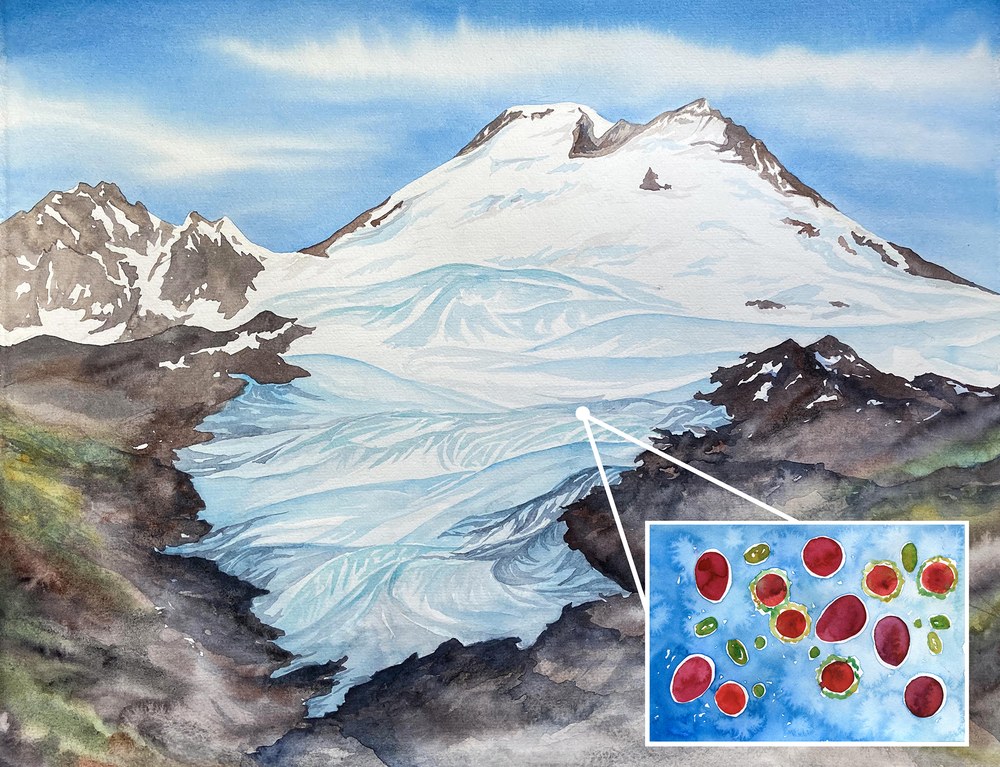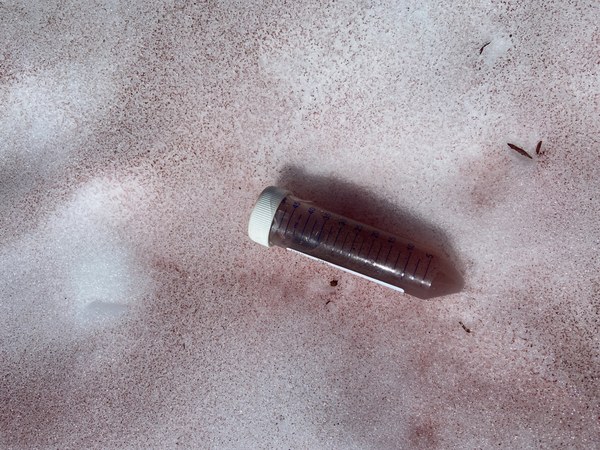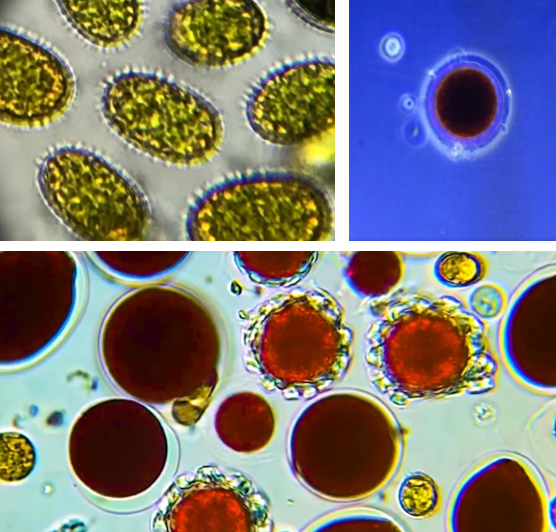
The incongruous streaks of red and pink on the snowfield look like faint blood stains across the side of the mountain. I quicken my pace, excited to finally find my quarry after two days of hiking in the Goat Rocks Wilderness. I step gingerly onto the snow and head straight for the darkest patch of red as I pull a sample tube out of my pocket. I fill it with the vibrant, pink-tinted snow, screw on the cap tightly, and label it with my coordinates. This small vial, which at first glance looks like a prop in a bad horror movie, is filled with tiny bits of algae that live a fascinating life in the mountains – one that is tied to the larger stories of climate change in our home ranges.
 Sample of watermelon snow. Photo by Claire Giordano.
Sample of watermelon snow. Photo by Claire Giordano.
After filling my sample tube I store it securely in my pack, snap a few photos, and record my location and observations in the Living Snow Project app. As I wander off to paint, my eyes rove the landscape looking for a good scene to sketch. “Watermelon snow,” or “pink snow,” results from algae that leaves a distinctive red, orange, or pink tint on the surface of a snowfield. As a volunteer and citizen scientist, I’m collecting these samples for the Living Snow Project run by Dr. Robin Kodner at Western Washington University.
The project’s goal is to “engage the outdoor recreation community in research that is characterizing the biodiversity of pink snow and its impact on snowmelt dynamics.” When we collect samples and record watermelon snow sightings, we are contributing to research into the different snow algae species and the connections between algae blooms and climate change. Although snow algae blooms are a natural part of the summer cycle in the mountains, they can also increase the rate of snow and glacier melt. This occurs because the colorful algae absorbs more solar radiation than clean snow does, leading to faster snow melt and the resulting negative impacts on alpine environments.
As an artist I’m always looking at the patterns, colors, and shapes of a landscape, especially those connected to environmental changes. When I volunteered for the Living Snow Project for the first time last summer, my eyes were opened to a whole new story of life and change in the mountains.
Like all scientific projects, especially those that look at changes over time, the Living Snow Project needs data. Thanks to the efforts of volunteers, Dr. Kodner is building the largest database of snow algae species and blooms in the world.
I just ordered my sample kits for this summer, and I am already looking forward to searching for watermelon snow this season. Participating in the Living Snow Project is one small way that I can help scientists better understand how the landscapes I love are changing. And during a year of heat waves, glacier loss, and huge wildfires, contributing to the Living Snow Project was something small yet significant that I could do.
 Snow algae microscope slides. Images courtesy of the Living Snow Project.
Snow algae microscope slides. Images courtesy of the Living Snow Project.
Participate in the Living Snow Project
Volunteers can contribute to the Living Snow Project in three ways: reporting sightings of pink/red/orange snow in the Living Snow Project app, collecting physical samples, and participating in the Snow Algae Atlas Project. The algae growing season usually begins in April or May and goes through the end of summer, or when the snow melts. You can participate at any time throughout this period.
Report sightings
- To get started, register on the project’s website: bit.ly/living-snow-project-volunteer
- Next, download the Living Snow Project app. This is where you can share algae location, photos, and notes.
Collect physical samples
- Register on the website (link above) and check if you live near an in-person pickup location. If not, request a sample kit be mailed to you.
- After you receive your sample kit, read the directions and stow it in your pack.
- Once you find snow algae, look for an undisturbed patch of snow to sample. Fill your sample bottle with pink snow using the cap and a glove to scoop it up. Seal it, record the coordinates of the sample using the app or a GPS device, and add your observations to the app.
- Bring your sample to a drop-off location, or ship it to the Living Snow Project as soon as you can. This helps to ensure that the algae is well preserved when the research team receives it.
Participate in the Snow Algae Atlas Project
The Atlas Project enlists recreationists to hike to a set of GPS coordinates to see if satellite predictions about a snow algae bloom are correct. This is the most involved (and some argue the most thrilling) of the citizen science options! Learn more and get involved: bit.ly/snowalgaeatlas
This article originally appeared in our Summer 2022 issue of Mountaineer magazine. To view the original article in magazine form and read more stories from our publication, visit our magazine archive.
 Claire Giordano
Claire Giordano